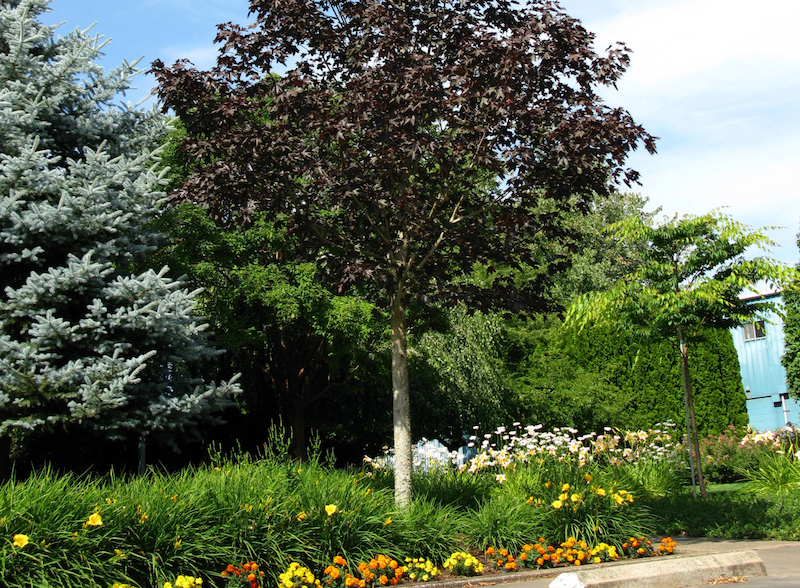If searching for a relatively low-maintenance shade tree, look at the hardy Acer genus. Maples, such as red, sugar, silver, and Japanese, provide shade in the spring, summer, and early fall, accompanied by brilliant swathes of varying colors. They are also easy to plant depending on their relative sizes at planting time.

Make sure, though, to choose an appropriate location and a suitable species of maple before planting. Doing so will prevent a lot of unwanted headaches later down the line as your maple matures. Hardiness, maximum height and spread, and aggressive roots are all critical factors to consider when it comes to potential disruptions of home foundations, patios, power lines, driveways, and sidewalks.
Maples are typically hardy in zones 3 to 9 and differ significantly in their maximum heights and spreads. Silver maples, for example, can grow to heights of 50 to 80 feet and spreads of 35 to 50 feet, versus dwarf Japanese maples that grow to heights of only 3 to 9 feet and spreads of 3 to 10 feet. Additionally, a few species of maple, such as silver maple, have more aggressive roots than others. Consider all of these factors before planting.
What You Need To Plant Maple
- Shovel
- Garden spade/digging bar
- Good location
- Water source
- Compost/mulch
- Wooden stakes
- Tree support straps
Where to Plant Maple
Maple trees enjoy sun and shade, so choose a location that receives full to partial sun. Ensure the soil is moist, loamy, acidic, and drains well. Do not amend the backfill dirt, as soil amendments can limit the roots' growth into the surrounding native soil and lead to tree failure. If the soil's characteristics are not suitable for maple, choose another location or another species that is suitable. The hole should be two to three times as wide as the tree's root ball and about as deep as the height of the maple's root ball.
Maple Spacing
Choose a good location that will still accommodate the tree after it fully matures. Selecting the best spot now will save you from spending thousands of dollars later. To choose the best site, research your tree’s maximum height and spread and its estimated root spread. A silver maple, for example, reaches heights of 50 to 80 feet and spreads 35 to 50 feet. As a result, you should plant this tree at least 50 feet away from any electrical lines.
Additionally, since a silver maple has a very aggressive root system that often grows wider than its maximum spread, site it away from cement foundations, driveways, sidewalks, swimming pools, fences, and underground wiring and piping. Finally, if planting more than one maple, choose a spot that is no closer than 50% of the combined maximum spreads of both trees from the other maple. For two silver maples, that would be 50% (50 feet +50 feet) or 50 feet.

Steps To Plant Maple
Step 1 - Choose a suitable maple specimen and location.
Step 2 - Dig a hole as deep as maple’s root ball and 2- 3 times as wide.
Step 3 - Place maple in the hole.
Step 4 - Backfill and tamp.
Step 5 - Water thoroughly.
Step 6 - Apply a 3-4-inch mulch ring around maple’s root zone.
Step 7 - Stake maple and attach tree support straps.
When to Plant Maple
The best time to plant maple is during the spring or autumn when the temperatures are moderate. You want to avoid planting during extreme weather such as a hard freeze or excessive heat. To minimize the risk of transplant shock, plant in early morning or late afternoon on an overcast day. Ensure the maple is adequately hydrated before planting.
Transplanting Maple
You can transplant a maple tree if it is less than three years old or shorter than 8 feet high. The best time to transplant is in spring or fall, when the maple is still dormant and the ground is not frozen. Due to the labor involved, ask someone to help. Professionals should preferably move taller trees due to the large size of the tree’s root ball. Examine the maple to see what size root ball it most likely has. Start prodding the dirt around the tree with a shovel to identify the root ball’s general circumference. Then, dig a new hole 2 to 3 times wider and about as deep as the root ball. Next, dig the tree with a shovel, carefully cutting as few roots as reasonably possible. Transfer the maple by hand or tarp to the new hole, place it in the hole, and backfill with native soil. Tamp down the soil, water, and apply a 3-4-inch ring of mulch around the tree’s trunk. If necessary, loosely stake the trunk if less than one year old.
 |
Author Suellen Barnes - Published 4-27-2023 |
